Abstract
In urban areas, private yards can make up large portions of the available “green space” which can be used to provide resources for many species, including birds, and pollinators. If residents are persuaded or willing to plant certain native plants, the aggregate effect of these plantings could be hugely beneficial for key pollinator species. The objectives of this study are to uncover impediments to adding different types of pollinator-beneficial plants to private yards, as well as ascertain which incentives to plant these native plants might be most persuasive, and finally determine if there are procedural knowledge gaps in how to plant, care for, or where to purchase three pollinator-beneficial plants. In this study, we randomly selected properties in two counties in southwestern Ohio along two gradients: parcel size and parcel valuation (as a proxy for income). Two hundred surveys were distributed and 113 were returned (57% response rate). We find that, in aggregate, respondents do not have a strong intent to plant these native plants, especially Asclepias syriaca (a milkweed that serves as host plant to the iconic monarch butterfly; Danaus plexippus) and, surprisingly, the intent to plant these does not differ statistically even when help with costs, labor, or the provision of online resources are offered. We also find that the reported knowledge of where to purchase wildflowers is significantly higher than how to care for them and how to plant them. Lastly, respondents are much more confident in how to take care of trees compared to the three pollinator-beneficial plants shown in the survey. We discuss the implications of these findings for outreach and extension purposes.
1. Introduction
As humans continue to appropriate Earth’s resources [1], finding novel ways to provide habitat and resources for species other than humans is needed. One of many potential approaches is to add native plants to private yards or gardens in urban, suburban and exurban (i.e., peri-urban) areas. Indeed, yards can positively contribute to species richness and abundance of some species [2,3], especially if they contain native plants [4]. In particular, private yards can provide enough floral resources and diverse plants necessary to maintain bee communities [5]. They have the potential to provide many more needed resources for bees, but also iconic species such as the monarch butterfly, i.e., Danaus plexippus [6,7,8]. However, this opportunity depends on what is planted (or not) in these private gardens as not all green spaces are created equal.
Given that residential gardens operate as a complex adaptive socio-ecological system, the plants that are found in yards are a result of a multitude of interacting and multiscalar human and ecological drivers [9,10]. The decision to add native plants in particular (or keep the native species that were planted by a previous owner, or the landscape architect/contractor) can be viewed through the lens of pro-environmental behavior model [11] and will depend on many factors including attitudinal and structural factors (e.g., plant aesthetics, time, values), the influence of formal and informal institutions (e.g., homeowners association rules; [9]), impact, procedural, and normative knowledge [12], knowledge of the plants’ ecological value, social norms [13], income [14], and habits [11] to name a few.
While the pro-environmental behavior model (or variations of it) is generally accepted, the weight of influence of the variables that comprise it of varies depending on which pro-environmental behavior is considered. Furthermore, Kollmuss and Agyeman [11] specify how there can exist a gap between a) environmental knowledge, values, attitudes, and awareness, and b) pro-environment choices and behaviors. This gap can be explained by the presence of barriers to executing the “desired” behavior including external incentives (socioeconomic and cultural factors for example), strength of internal incentives (e.g., value system), negative or insufficient feedback about the particular pro-environmental behavior, old behavior patterns (i.e., habits), lack of time, weak environmental consciousness, and knowledge gaps [11]. In order to design effective programs to elicit pro-environmental behaviors, it is important to know the strength of the aforementioned drivers as well as the perceived or real benefits and barriers to desired behaviors and the perceived or real benefits and barriers to the competing (undesired) behaviors [15].
Known barriers to adding native plants to landscapes include their lack of availability in wholesale and retail nurseries [16], preferences for some homeowners for large flowers and wide green leaves [17], the thought that yards that include these plants can seem “messy” [18,19], pressure from social norms [13,20], the “belief that native plants belong in the city [14], influence of socioeconomic factors [14,21], maintenance needs [22] and people’s familiarity with the plants [23], but also characteristics of yards themselves including yard size [24]. While much has been done in this regard few studies compare people’s desire to plant different native plants, as well as procedural knowledge of planting native plants and how that interacts with intent to plant these plants.
Consequently, ascertaining people’s intent to plant various native plants within the context of the timing of when to plant them, or whether some barriers such as help with purchasing the seeds, or the labor that needs to go into planting or knowledge of how to plant, purchase and care for these plants is needed. Additionally, understanding if certain native plants are more of less desired could be useful as well. Finally, trying to uncover knowledge gaps surrounding key aspects of adding these plants to yards can also help in designing programs to help homeowners add natives to their gardens.
The objectives of this study are to uncover impediments to adding different types of pollinator-beneficial plants to private yards, as well as ascertain which incentives to plant these native plants might be most persuasive, and finally determine if there are procedural knowledge gaps in how to plant, care for, or where to purchase these pollinator beneficial plants. We focus on the following pollinator beneficial plant types: purple coneflower (Echinacea purpurea), common milkweed (Asclepias syriaca), and wildflowers (multiple spp.). We ask the following questions:
- Is there a difference in mean stated willingness to add the pollinator beneficial plants shown in the survey based on offers of different types of assistance (e.g., help with cost or labor) or the timing of when to plant pollinator beneficial plants (this season or next time changes will be made to respondents’ landscaping)?
- Is the self-disclosed knowledge of how to plant, care for, and purchase E. purpurea statistically different, i.e., do the respondents report they are more or less knowledgeable about planting, caring, or purchasing E. purpurea? Similarly, is the self-disclosed knowledge of how to plant, care for, and purchase A. syriaca or wildflowers statistically different? Additionally, is the self-disclosed knowledge of how to plant and care for trees significantly different?
- Does self-disclosed knowledge of how to plant, care for, and purchase pollinator beneficial plants differ between the different plant types shown in the survey, e.g., do the respondents feel more knowledgeable about planting E. purpurea compared to wildflowers or A. syriaca and so forth? For this question set, we also compare some of the answers to the self-disclosed knowledge of planting and caring for trees as a comparison group.
- What are the most frequently cited barriers to adding the plants shown in the survey to respondents’ yards?
The results of this research could be used to develop and tailor outreach and extension materials and programs designed to increase pollinator beneficial plantings in the Midwestern United States.
2. Methods
2.1. Study Area and Sampling Approach
The study area consists of two counties in the midwestern United States of America (U.S.A.): Darke and Miami counties. Both are located in Southwest Ohio and sit within the Dayton-Springfield-Sidney Combined Statistical Area delineated by the U.S. Census Bureau. Combined Statistical Areas are defined by the Census Bureau as “the county or counties (or equivalent entities) associated with at least one core (urbanized area or urban cluster) of at least 10,000 population, plus adjacent counties having a high degree of social and economic integration with the core as measured through [strong] commuting ties”. Both Darke and Miami counties contain medium-sized cities (Greenville, Troy, and Piqua) and exhibit suburban to rural urbanization patterns, especially moving north, i.e., away from Dayton, Ohio (Figure 1). Except for the urbanized areas with strong suburban and exurban (peri-urban) development, the region is mostly agricultural, dominated by corn and soybeans, with some forest remnants.
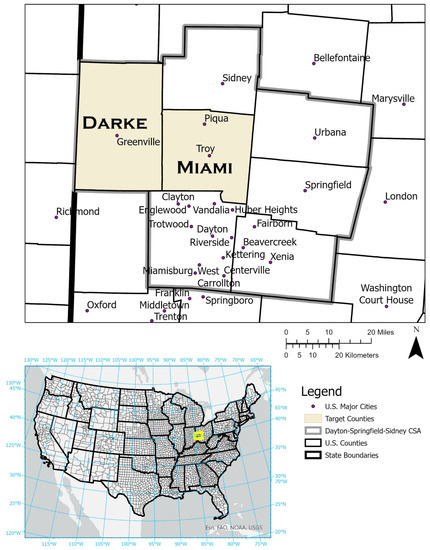
Figure 1.
Study area. Study area map displaying the two counties (Darke and Miami counties in Ohio, U.S.A) from which single-family homes were randomly selected. Additionally, shown are states for the conterminous U.S.A. and the Dayton-Springfield-Sidney Combined Statistical Area (CSA) as designated by the United States Census Bureau, as well as cities in the U.S.A. with more than 10,000 inhabitants. The yellow box in the lower map shows the location of the study region with respect to the United States of America (and within the State of Ohio).
Using parcel data obtained from Darke and Miami Counties’ assessors in 2019 we selected parcels for which the land-use code was single-family residential. From the 81,859 parcels located in both counties, we were left with 16,390 candidate properties. From those, we randomly selected 200 properties along two strata, i.e., property valuation and parcel size, so that we could ensure a range of respondents from various socio-economic backgrounds and property types. The selected households received a survey that shows pollinator beneficial plants native to the region but of differing appearance, management needs, and pollinator service. These were purple coneflower (Echinacea purpurea), common milkweed (Asclepias syriaca), and wildflowers (multiple spp.).
We ascertained respondents’ knowledge of each plant and willingness to add each plant to their yards by asking respondents to rate on a 5-point Likert scale of “Strongly Disagree,” “Disagree,” “Neither Agree Nor Disagree,” “Agree,” and “Strongly Agree” whether they: (1) know how to plant, (2) how to care for, (3) where to purchase seed, (4) whether they would add (or add more) of the plants shown in the survey to their yard next year, (5) whether they would add (or add more) of these plants to their yard next time they made changes to their landscape, (6) would likely add these plants if help with seed cost was provided, (7) would likely add these if online resources regarding the purchase, planting and care of these plants was received, and (8) would likely add these plants if help with labor is received. For comparison purposes, we also asked some of the aforementioned questions for trees in general. The full survey instrument can be found in Appendix A.
Surveys were dropped off or left with respondents in Darke and Miami counties, Ohio. Selected residents were contacted up to four times total. All initial surveys were distributed from mid-July to mid-August 2019. The first contact consisted of dropping off the survey at people’s homes without prior contact or notification. If a resident did not answer, the clear bag containing the survey and a $2 bill (as incentive) was hung on the doorknob for the respondent to find later. The second contact consisted of a postcard, sent to all respondents, thanking those who took the survey and gently nudging those who did not, to take the survey. The third contact consisted of another copy of the survey mailed to all the non-respondents two weeks after the second contact. The fourth and final contact was another reminder and thank you postcard. The final postcard emphasized the importance of the residents’ individual answers and explained this was the last time we were going to be contacting them. The verbiage for the contact letters and postcards followed examples found in Dillman et al. (2014).
We obtained approval prior to conducting the research through Miami University’s Institutional Review Board (IRB). Our project reference number is 03270e.
2.2. Statistical Analysis
We examined whether the response variables were statistically different for the different groups using one-way Analyses of Variances (ANOVAs) with repeated measures, performed using the lme package in R [25]. The stated willingness to add the proposed plants in the following year varied from 1 to 5 with 1 standing for “Strongly Disagree” and 5 “Strongly Agree”, therefore a mean of three stands for neutral responses. For the ANOVAs where the group means were significantly different, we performed post hoc multi-comparison tests with a Bonferroni adjustment for multiple comparisons to determine which group means differed statistically. Prior to performing the ANOVAs, we visually assessed that the data in each group were normal (or for the one-way ANOVAs with repeated measures we examined whether the difference between groups was normal). We used Bartlett tests to check for heteroscedasticity.
Lastly, to categorize the reasons respondents wrote as reasons why they might not want to add the various plant choices shown in the survey, we read their answers twice and grouped the answers into similar concerns and counted the occurrences. Note that not all respondents chose to answer these questions, and that some respondents wrote in multiple reasons.
Statistical analyses were performed in R version 3.6.1 (R Core Team, 2019). Aside from those mentioned above, we used the following R packages in our analyses: foreign, ggplot2, psych, dplyr, Rmisc, multcomp.
3. Results
Out of 200 surveys distributed, we received 113 responses (57% response rate). Below, we summarize the research questions and results, including summaries of the statistical analyses if applicable.
3.1. Is There a Difference in Mean Reported Willingness to Add the Pollinator Beneficial Plants Shown in the Survey Based on Offers of Different Types of Assistance (e.g., Help with Cost or labour) or the Timing of When to Plant Pollinator Beneficial Plants (This Season or Next Time Changes Will Be Made to Respondents’ Landscaping)?
According to a one-way analysis of variance (ANOVA) with repeated measures, the mean reported willingness to plant E. purpurea does not differ between various offers of assistance or timing (F(4,425) = 0.93, p = 0.45; Table 1). Similarly, two separate one-way ANOVAs with repeated measures indicate that the timing or offer of various types of assistance does not affect the reported willingness to plant A. syriaca (F(4,423) = 0.96, p = 0.43) or wildflowers (F(4,427) = 1.12, p = 0.35; Table 1).

Table 1.
Summary statistics for reported intent to plant the native plants shown in the survey when various types of assistance or options for different timing of plantings are given. Mean +/− 1 standard deviation (SD) and median for stated willingness (i.e., reported intent) to plant purple coneflower, common milkweed and wildflowers if assistance is provided with costs, labor, or provision of online resources; mean +/− 1 standard deviation (SD) and median for stated willingness to add the particular plant within the next year, or the next time landscaping changes are made to the yard. Higher values indicate that the respondent is more willing to plant the plants shown in the survey. The scale varies from 1 to 5, with 5 standing for “Strongly agree,” and 1 “Strongly disagree” so that a value of three is neutral (“Neither agree nor disagree”). All means are below three, but especially for common milkweed. The number of respondents who answered each question is provided in the column labelled n.
3.2. Is the Self-Disclosed Knowledge of How to Plant, Care for, and Purchase E. purpurea Statistically Different, i.e., Do the Respondents Report They Are More or Less Knowledgeable about Planting, Caring, or Purchasing E. purpurea? Similarly, Is the Self-Disclosed Knowledge of How to Plant, Care for, and Purchase A. syriaca or Wildflowers Statistically Different? And Is the Self-Disclosed Knowledge of How to Plant and Care for Trees Significantly Different?
We find no difference in the self-disclosed knowledge of how to plant, care for, and purchase both E. purpurea and A. syriaca (F(2,214) = 1.25, p = 0.29, and F(2,210) = 1.40, p = 0.25, respectively). This is not the case for wildflowers (F(2,216) = 7.72, p = 0.0006, Table 2) or for trees (W = 55, p = 0.003, Table 2). Note that a Wilcoxon signed rank test had to be performed to ascertain whether planting and caring for trees was different because the difference between the two was severely non-normal. The mean reported knowledge of where to purchase wildflowers (M = 3.5, SD = 1.1) is significantly higher than how to care for them (M = 3.3, SD = 1.2) and how to plant them (M = 3.2, SD = 1.2; Table 2). Similarly, respondents’ reported knowledge of how to plant trees (M = 4.1, SD = 0.9) is significantly higher than how to care for trees (M = 4.0, SD = 0.9; Table 2).

Table 2.
Summary statistics for reported knowledge of planting, caring for, and purchasing the three pollinator-beneficial plants shown in the survey (as well as for trees as a comparison group). Mean +/− 1 standard deviation (SD) and median for reported knowledge of where to purchase, how to plant, and how to care for purple coneflower, common milkweed and wildflowers. Note that the “where to purchase trees” question was not included in the survey instrument. We conducted three one-way repeated-measures ANOVAs to test whether the mean reported knowledge about how to plant, care for, or purchase each of the plants shown in the survey was different. The groups are the reported knowledge categories. The plant types were Echinacea purpurea, Asclepias syriaca, and wildflower prairie (multiple species of native plants). Higher values indicate that the respondent believes they are more knowledgeable. The scale varies from 1 to 5, with 5 indicating that the respondent strongly agrees with the statement (e.g., “I know how to care for wildflowers”). A value of one indicates the respondent strongly disagrees with the statement so that a value of three is neutral (“Neither agree nor disagree”). There is no significant difference between the knowledge questions for purple coneflower or common milkweed so not further tests were conducted. For the ANOVA for the wildflowers, the p values reported for the post hoc test of multiple comparisons is Bonferroni adjusted. ^ To compare responses for caring and planting for trees since the difference between reported knowledge of planting and caring for trees is severely non-normal and there were only two groups a Wilcoxon signed rank test is used. The number of respondents who answered each question is provided in the column labelled n. Asterisks *, **, and *** denote 5%, 1%, and 0.1% levels of significance, respectively when testing the null hypothesis that the coefficients equal zero.
3.3. Does Self-Disclosed Knowledge of How to Plant, Care for, and Purchase Pollinator Beneficial Plants Differ between the Different Plant Types Shown in the Survey, e.g., Do the Respondents Feel More Knowledgeable about Planting E. purpurea Compared to Wildflowers or A. syriaca, and so Forth
Knowledge of where to purchase the different plants in the survey does differ significantly (F(2,208) = 44.63, p < 2 × 10−16, Table 3.) Respondents are significantly less likely to know where to purchase A. syriaca (M = 2.6, SD = 1.2) compared to E. purpurea (M = 3.5, SD = 1.1) as well as wildflowers (M = 3.5, SD = 1.1). Knowledge of how to care for the plants shown in the survey as well as trees also differs statistically between groups (F(3,312) = 53.94, p < 2 × 10−16, Table 3). Respondents are significantly less sure how to care for A. syriaca (M = 2.7, SD = 1.2) compared to E. purpurea (M = 3.4, SD = 1.2), and are much more confident in how to take care of trees (M = 4.1, SD = 0.9; Table 3) compared to the other three plants shown in the survey. The same patterns can be seen in the responses for how to plant these plants. The mean reported knowledge of how to plant the various pollinator beneficial plant choices shown in the survey differs statistically (F(3,314) = 53.23, p < 2 × 10−16) with respondents stating they are much more knowledgeable about how to plant trees (M = 4.0, SD = 0.9), than E. purpurea (M = 3.4, SD = 1.2) and A. syriaca (M = 2.6, SD = 1.1). Overall, respondents say are much less knowledgeable about planting A. syriaca compared to the other plants shown in the survey (Table 3).

Table 3.
Statistical comparisons for the reported knowledge of how to plant, care for, and purchase for the different native plants shown in the survey as well as for trees. Mean +/− 1 standard deviation (SD) and median for reported knowledge of where to purchase, how to plant, and how to care for purple coneflower, common milkweed and wildflowers (Echicanea purpurea, Asclepias syriaca, and multiple spp. of wildflowers, respectively). Note that the “where to purchase trees” question was not included in the survey instrument. We conducted a one-way repeated-measures ANOVA to examine whether the mean reported knowledge about how to plant, E. purpurea, A. syriaca, and wildflowers were different. The same analyses were conducted for the other knowledge statements, i.e., “know how to care for” and “know where to purchase”. Higher values indicate that the respondent believes they are more knowledgeable. The scale varies from 1 to 5, with 5 indicating that the respondent strongly agrees with the statement (e.g., “I know how to care for wildflowers”). A value of one indicates the respondent strongly disagrees with the statement so that a value of three is neutral (“Neither agree nor disagree”). The p values reported for the post hoc test of multiple comparisons are Bonferroni adjusted. The number of respondents who answered each question is provided in the column labelled n. Asterisks *** denote 0.1% levels of significance.
3.4. What Are the Most Frequently Cited Barriers to Adding the Plants Shown in the Survey to Respondents’ Yards?
The most oft-stated reasons respondents mention why not to add the plants shown in the survey are a general dislike for the appearance of the plants (especially for A. syriaca, and E. purpurea), that the plants require or are perceived to require more maintenance than the respondent is willing or has the ability to expend, that the plant(s) spread too much on their own, and for A. syriaca that it is considered a weed or invasive plant (Figure 2). Please note that these are reasons specified by the respondents in an open-ended portion of the survey, i.e., there were no predetermined answer choices for this question on the survey. Overall, the reasons respondents list as to why they might not want to add E. purpurea, A. syriaca, and wildflowers to their landscaping overwhelmingly have to do with visual appeal and appearance, maintenance considerations or lack of knowledge of how to care for these plants, and considerations about the plants spreading beyond the planted area, as well as for A. syriaca concerns about it being a weed, or an invasive, or toxic to pets and livestock.
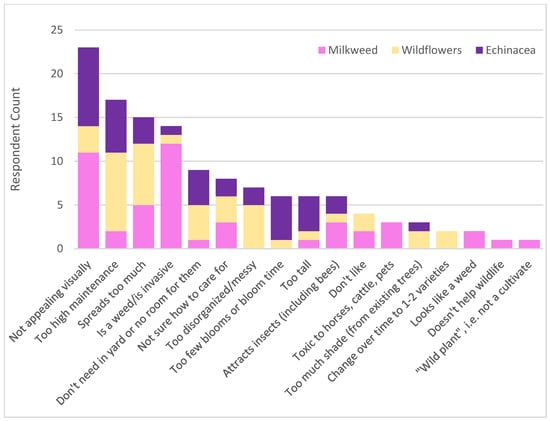
Figure 2.
Key barriers to adding the pollinator beneficial plants shown in the survey. Number of times (counts) a respondent stated a particular reason as to why they might not like to add Asclepias syriaca (Common Milkweed; pink bars), Echninacea purpurea (purple coneflower; purple bars), or wildflowers (multiple spp.; orange bars) to their yard. This was an open-ended question on the survey instrument. Out of the 113 respondents to the survey, 48 chose to write at least one reason down in the answer box provided for that purpose for E. purpurea, 57 for A. syriaca, and 54 for wildflowers.
4. Discussion
The fact that many respondents mentioned they did not care for the plants’ visual appearance is expected as these plants do not conform to the traditional aesthetics of yards with neat (weed-free) lawns and ornamental showy flowers, yet the desire for those types of gardens is prevalent across the U.S.A. [26]. Others have found that in the Southwestern United States native landscapes were perceived as unattractive and high maintenance, but “86% [of respondents said they] would use native plants if native plants were attractive” [27]. These results were influenced by education and time spent on horticultural activities. Similarly, in a study of ecological and socioeconomic factors that affect plant richness composition in residential gardens in Minneapolis MN, the most important characteristics for planting decisions were “aesthetics, wildlife, neatness, and food provision” [16].
Unfortunately, most of the undesired characteristics of the plants shown in the survey (and other pollinator beneficial plants) seem difficult to counter although some organizations (e.g., the Cincinnati Zoo and Botanical Garden®) do produce plant guides that promote adding plants that would bloom throughout the Spring, Fall, and Summer (https://cincinnatizoo.org/horticulture/plant-for-pollinators/resources/). Ostensibly, this is to provide forage for many insect pollinators during their active season, but can also help with a flower garden’s appearance over the growing season. Some of the guides also specify plant height, spread, size of flowers typically and thus can help alleviate some residents’ concerns as well. Finding ways to keep maintenance needs low for large plantings of these plants (especially weed-free and if possible lower to the ground) seems desired [22]. Perhaps a combination of these plants and groundcover could help counter some of these impediments and while research along those lines has been conducted in orchards, i.e., agricultural settings [28,29], to the best of our knowledge this is an active research need in urban settings (although see [30]).
Correcting the misconceptions surrounding A. syriaca with the general public is greatly needed especially since another study found similar concerns in large property owners and farmers of SW Ohio [6]. Indeed, A. syriaca is neither a weed nor an invasive plant in this region [31]. It is a native plant that, for full disclosure, can propagate by “sending up new shoots from roots that spread outward from the parent plant. This clonal reproduction allows their populations to expand over time, and plants may spread out of their original area. […] Despite the vegetative growth, many of these species are unlikely to create an ongoing and unmanageable weed problem for roadside managers (or for other land managers, homeowners, and others)” [32]. As to the fears of it being toxic to livestock and pets, this needs to be reframed. Indeed, even the ASPCA’s website states that milkweed can be toxic to dogs, cats, and horses and can cause their death [33] with no allusion to the fact that it is highly unpalatable to those species, that it would have to be ingested in large quantities to have those effects, that livestock only eat it if there is nothing else for them to eat, and that toxicity varies by milkweed species [34,35]. With that said, perhaps the survey respondents in this study just did not want to take the chance of accidental large quantity ingestion by pets which of course is understandable, but, for the purposes of this study, rather unsurmountable.
SW Ohioans were in general slightly unwilling to plant the native plants shown in the survey. Surprisingly, there is no difference in the mean stated willingness to plant these pollinator beneficial plants regardless of whether the timing of planting was within the following year or the next time landscaping changes were made, or whether assistance with cost, labor, or the provision of online resources were offered. This is especially true for A. syriaca as, collectively, respondents moderately disagreed that they were willing to plant it. Overall, these findings are rather problematic as they may indicate that the aesthetic and other considerations previously mentioned are paramount in these residents’ minds and since milkweeds spp. are the host plants for the monarch butterfly no substitutes can be used in this case. It also may mean that for the organizations that currently provide such incentives to interested homeowners, they are reaching a population that was already going to make the changes to their landscape regardless of the assistance. If this is the case, in the long term, it may be more difficult to find willing homeowners. We do not imply that initiatives that provide these types of incentives should be halted especially since they are one known effective strategy to help change behavior [36]; however, it seems wise to find other mechanisms by which to entice residents to put these plants and other pollinator beneficial plants in their yards. One example of an approach that worked for native plants in Dunedin (New Zealand), was to use biodiversity assessments and dialog with homeowners as it led to an increase in knowledge and positive shift in attitude towards native plant species [37]. After participating in the program, one quarter of participants incorporated native plants in their yard and 13% stated it was to improve biodiversity [37]. Another mechanism would include passing policies aimed at improving conservation efforts for pollinators, which is greatly needed [38,39], including in urban areas [40]. It is critical that these policies be enforced [41] and integrate the “perspective of farmers and local communities on the need to conserve pollinators, alongside scientific understanding” [42].
Other than for A. syriaca, reported knowledge of how to plant, care for or purchase the plants shown in the survey is strong although, for wildflowers and trees, survey respondents were significantly less certain of their abilities to plant these species compared to caring for them or purchasing them. Educational materials, including demonstrations, videos, and hands-on workshops might be valuable in this regard. Reported knowledge of purchasing, planting, and caring for A. syriaca is significantly lower than for the other plants shown in the survey and should be addressed if the vision of 1.3 billion new stems is to be achieved [8]. Whether or not these plants or seeds are widely available at nurseries and other retailers is a separate but important barrier to overcome [16,43,44,45].
Reported knowledge of how to plant and care for trees is high. Given the mistakes homeowners are known to make when it comes to tree planting and care [46,47] this is a bit alarming. It might be beneficial to educate homeowners about the needs of trees and it also may be an opportunity. Some trees provide abundant resources for pollinators [48,49,50] and given their general acceptability to residents, the fact they are easier to maintain, that their aesthetic value is generally high, that the area underneath can be mowed around and not take up large portions of a yard’s surface area, and that they provide many other ecosystem services, promoting pollinator beneficial tree plantings could be a straightforward way to provide floral resources for many pollinators and nesting resource for some. Of course, this proposed solution would not serve the monarch butterfly populations (Danaus plexippus).
Limitations and Future Research Needs
It is probable that the individuals who took the time to respond to this survey may have more affinity to gardening than non-respondents. Despite all the measures we took to increase response rate, 43% of selected households did not return a completed survey. Given that individuals who like gardening and view it as a hobby are associated with more wildlife supporting yards [22] the mean responses to the questions about intentions to plant the native plant species shown in the survey and the plant and gardening knowledge responses may be higher than they would be for the general population and this should be considered while interpreting the results presented herein.
We solely surveyed residents of single-family homes in suburban and peri-urban southwestern Ohio (USA). More research is needed to uncover whether these findings are universal across geographies, vary by yard size, structure, and classification (e.g., urban, versus suburban, versus exurban). An interesting area of research would be to examine whether different typologies of residents exist with regard to adding native plants to private yards as that could help tailor education and outreach programs for different constituents. Additionally, we examine people’s intention to add native plantings to their yards but there exists a gap between intention and behavior [51]. Conducting experiments to ascertain the width of that gap is greatly needed, although see Champine et al. [52] for such a study in Fort Collins, Colorado, USA and Knapp et al. [53] for empirical data on this gap in the United Kingdom. Lastly, if efforts to add pollinator-beneficial plants in yards are wildly successful, it will be important to know whether (and in what proportion) residents might take measures to control stinging insects in their yard. While insect pollinator knowledge and appreciation has increased over time [54], a study of residents in a county in SW Ohio found that approximately 5% of residents surveyed specified they would not like to see these plants in their yards because the plants attracted bees [55]. To the best of our knowledge, whether this sentiment translates to actively trying to eradicate these insects from one’s yard is unknown but should be examined closely.
5. Conclusions
The objectives of this study were to uncover impediments to adding different types of pollinator-beneficial plants to private yards, as well as ascertain which incentives to plant these native plants might be most persuasive, and finally determine if there were procedural knowledge gaps in how to plant, care for, or where to purchase these pollinator beneficial plants. Unfortunately, getting residents of single-family homes to voluntarily add A. syriaca (common milkweed) to private yards in quantities that are needed to support a thriving monarch butterfly population may prove to be difficult given SW Ohio residents seem to dislike the appearance of the plant, its mode of propagation, and have some preconceived notions as well as somewhat erroneous concerns about the plant itself (e.g., invasiveness). Focusing instead on planting large areas of milkweed (Asclepias spp.) along roadsides, on agricultural and government land, and exploring payments for ecosystem services options might be necessary.
Overall, SW Ohio residents’ intent to add the pollinator-beneficial plants shown in the survey to the yards of single-family homes is not high and, surprisingly, does not differ when incentives are offered; even when help with costs, labor, or the provision of online resources are proposed. Finding other ways to entice homeowners to plant native plants is necessary, especially given the gap between strong behavioral intentions to plant native plants and their actual addition to yards [52]. Experimenting with different approaches to elicit this pro-environmental behavior is needed, such as the one described in van Heezik et al. [37].
Procedural knowledge, i.e., knowledge of how to plant and care for A. syriaca, E. purpurea, and wildflowers is significantly lower than for trees. More education and outreach in this regard may be warranted. However, education and outreach materials and programs should consider ways to increase the visual appeal of the plantings (by for example providing “cues to care” [19]) and decrease maintenance needs (especially compared to the mindlessness and ease of taking care of turfgrass). Convenience is important when attempting to convince someone to adopt a pro-environmental behavior [36], especially planting wildlife friendly yards [22].
The results of this research could be used to design more effective education and outreach programs for Midwesterners, keeping in mind that the incentives proposed in this study are unlikely to substantially change the intent to plant these pollinator-beneficial plants. Other mechanisms (e.g., through policy and/or payment for ecosystem services) will most likely be needed to markedly increase the area of private yards devoted to native plants in general but milkweeds in particular in suburban/rural Southwest Ohio (USA).
Author Contributions
Conceptualization, A.D.; methodology, A.D and J.S.; software, A.D.; validation, A.D.; formal analysis, A.D.; investigation, A.D. and J.S.; resources, A.D.; data curation, J.S.; writing—original draft preparation, A.D. and J.S.; writing—review and editing, A.D. and J.S.; visualization, A.D.; supervision, A.D.; project administration, A.D.; funding acquisition, A.D. All authors have read and agreed to the published version of the manuscript.
Funding
This research received no external funding.
Institutional Review Board Statement
This research was approved through Miami University’s Institutional Review Board (IRB). Our project reference number is 03270e.
Informed Consent Statement
Informed consent was obtained from all subjects involved in the study.
Data Availability Statement
Anonymized survey responses can be requested by emailing the corresponding author.
Acknowledgments
The views expressed in this article are those of the author and do not necessarily reflect the official policy or position of the United States Air Force Academy, the Air Force, the Department of Defense, or the U.S. Government (PA#: USAFA-DF-2022-911). We are extremely grateful to the survey participants for taking the time to complete the survey. We are also thankful for funding from Miami University to complete this study. Without these elements this research would not be possible. Lastly, we want to extend a huge thank you to Debbi White, the departmental assistant for the Geography Department at Miami University for overseeing the stuffing of the survey packets and helping us navigate reimbursements for the field work. Her competence and can-do attitude as well as incessant hard work is immensely appreciated.
Conflicts of Interest
The authors declare no conflict of interest.
Appendix A
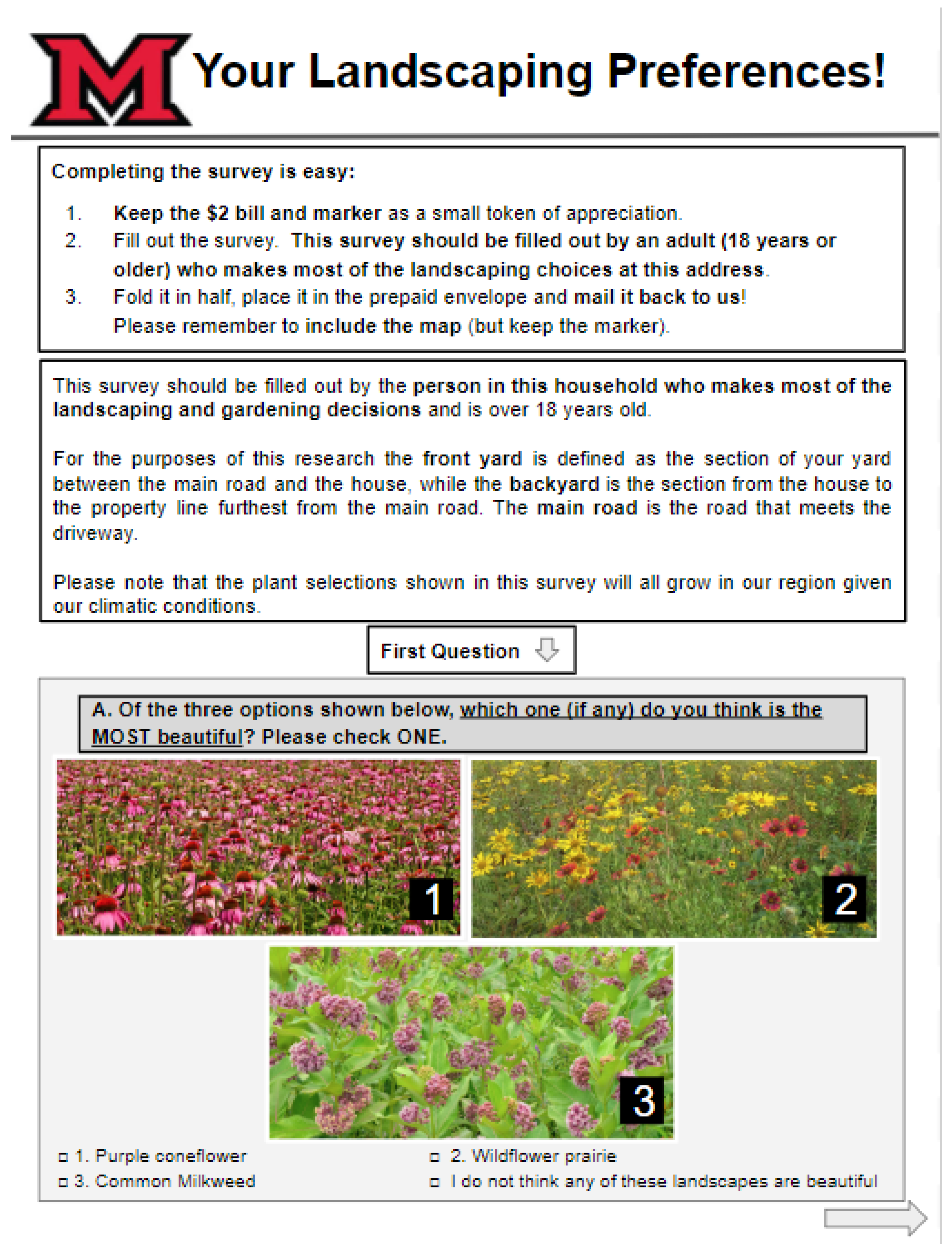
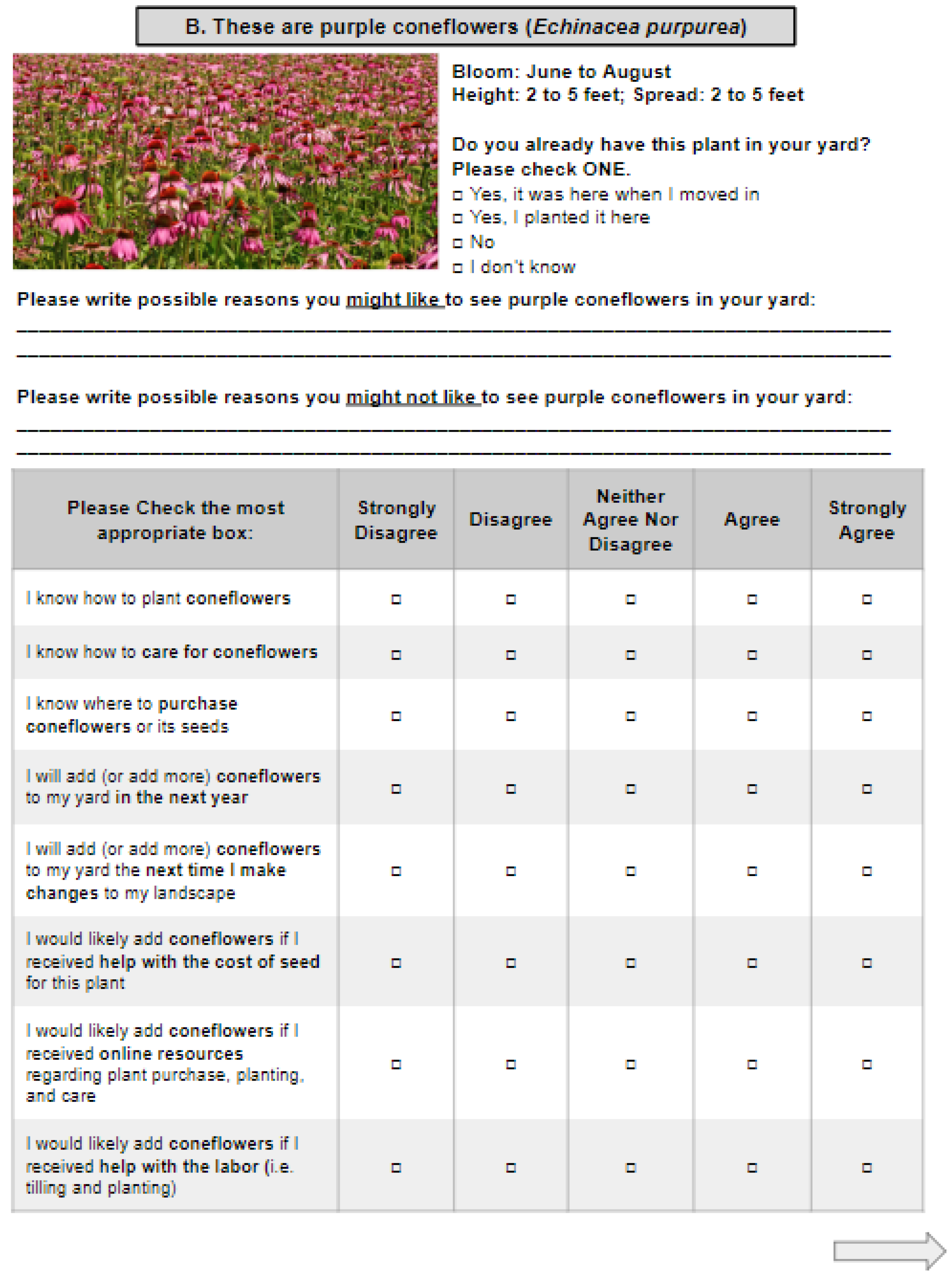
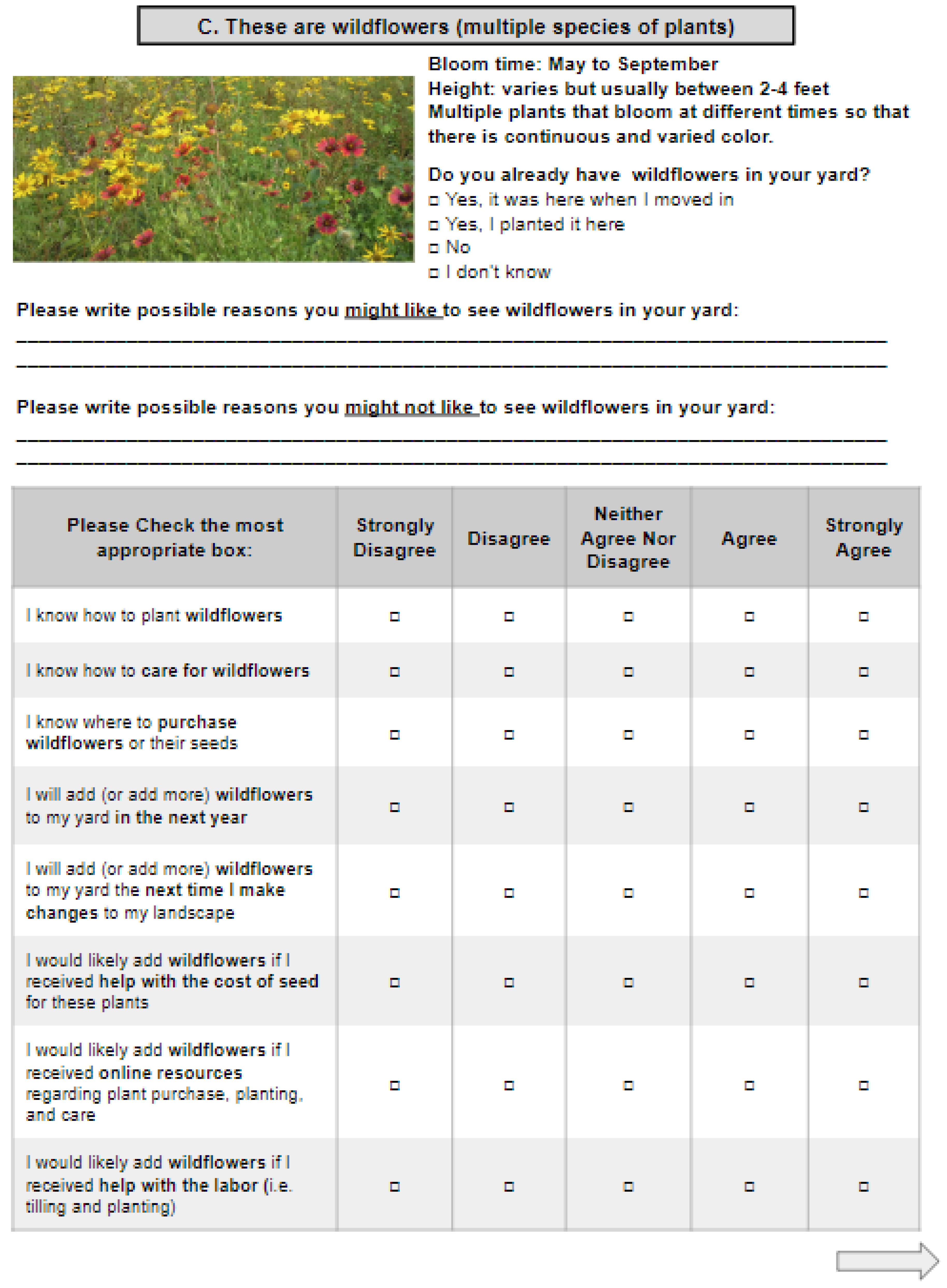
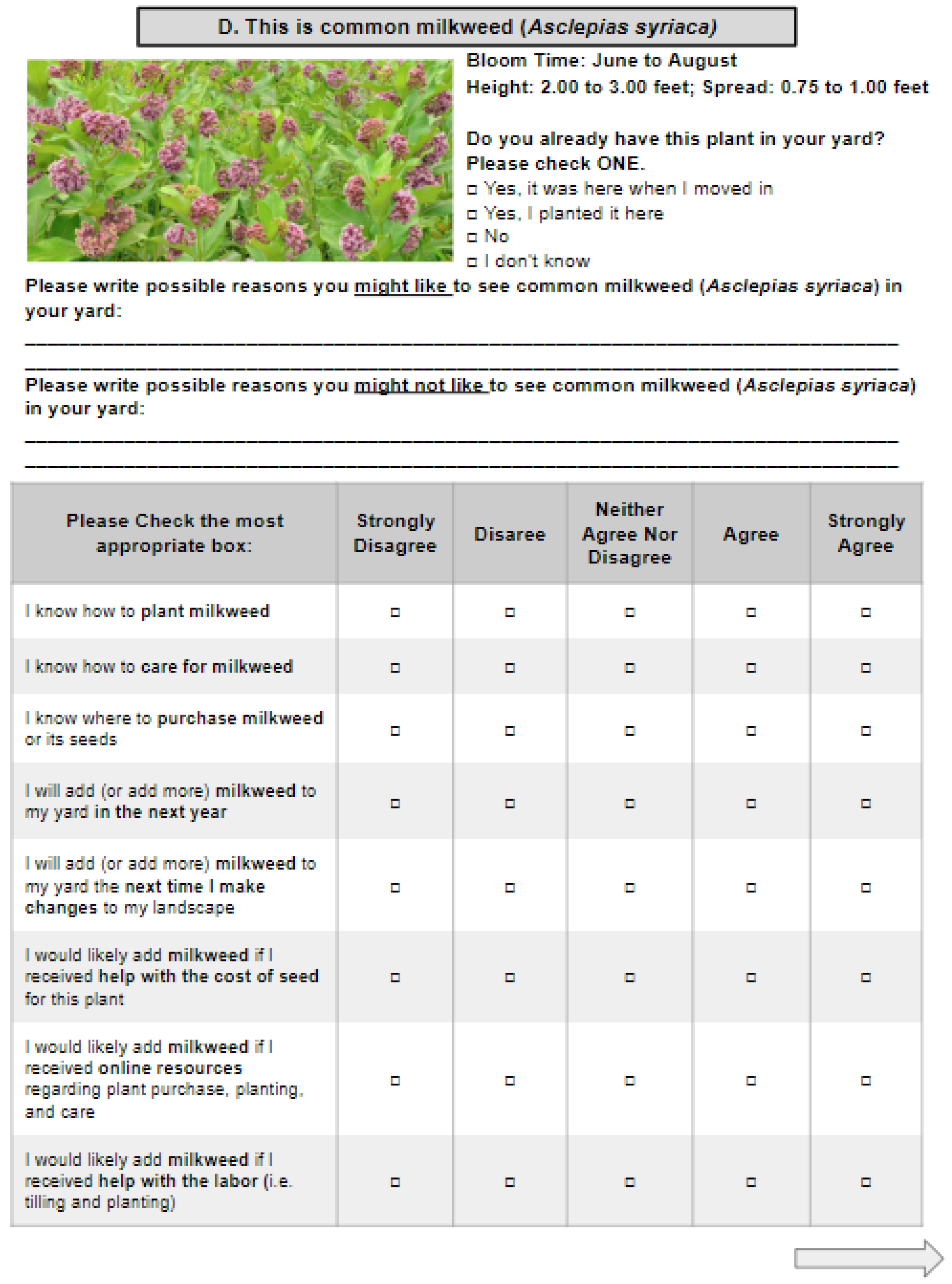

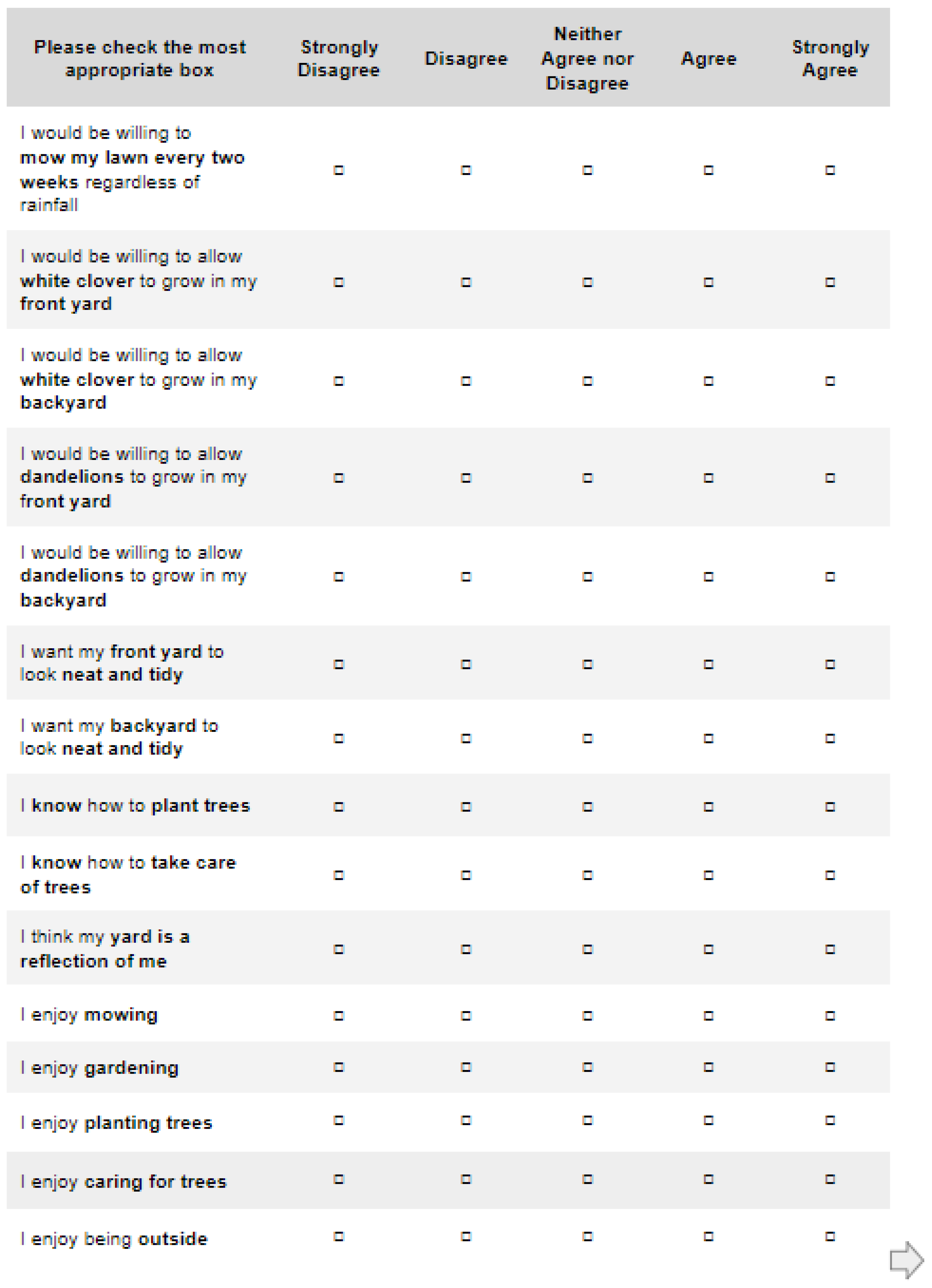
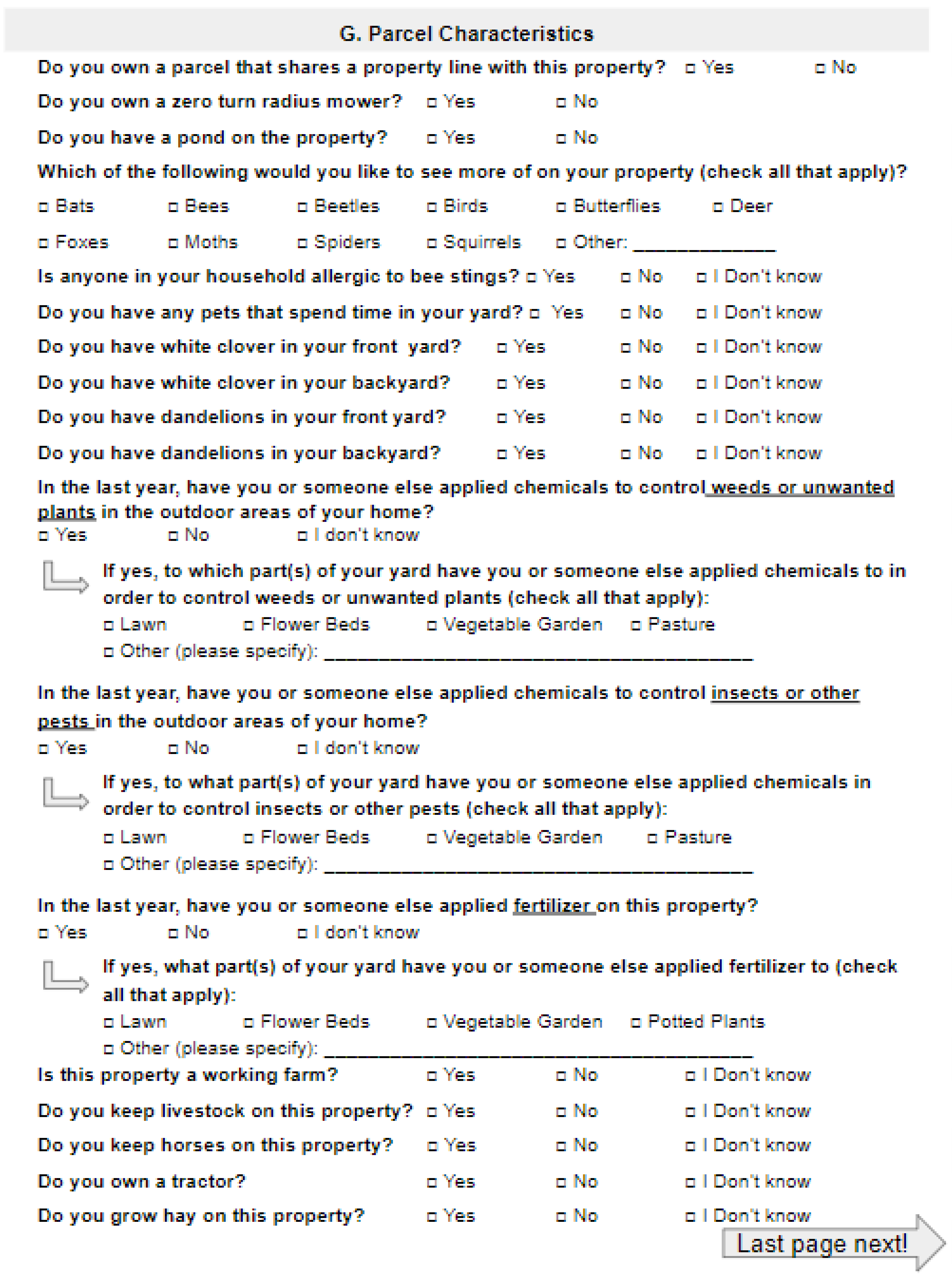
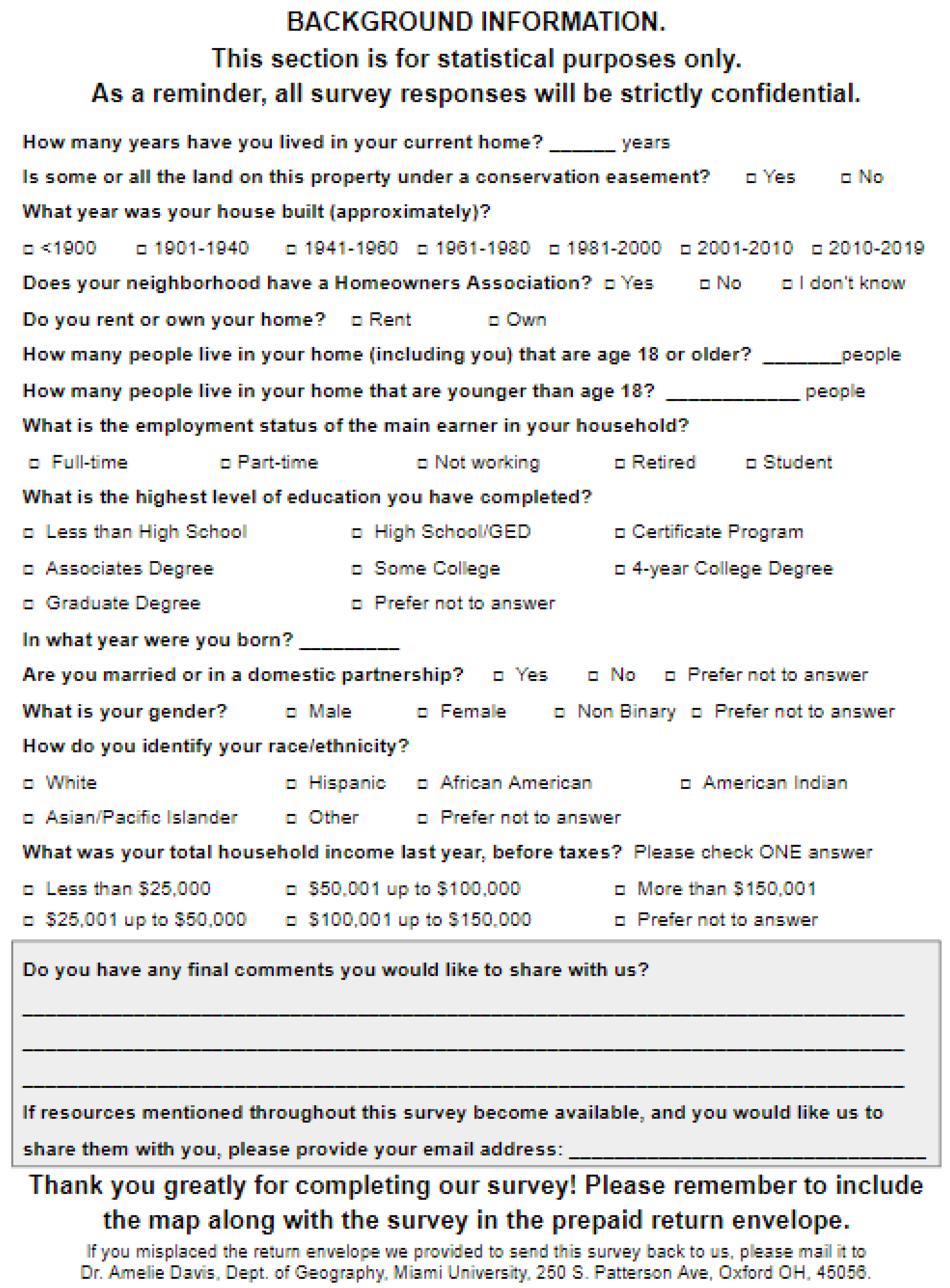
References
- Haberl, H.; Erb, K.-H.; Krausmann, F. Human appropriation of net primary production: Patterns, trends, and planetary boundaries. Annu. Rev. Environ. Resour. 2014, 39, 363–391. [Google Scholar] [CrossRef]
- Aronson, M.F.J.; La Sorte, F.A.; Nilon, C.H.; Katti, M.; Goddard, M.A.; Lepczyk, C.A.; Warren, P.S.; Williams, N.S.G.; Clilliers, S.; Clarkson, B. A global analysis of the impacts of urbanization on bird and plant diversity reveals key anthropogenic drivers. Proc. R. Soc. B Biol. Sci. 2014, 281, 20133330. [Google Scholar] [CrossRef] [PubMed]
- Lerman, S.B.; Warren, P.S. The conservation value of residential yards: Linking birds and people. Ecol. Appl. 2011, 21, 1327–1339. [Google Scholar] [CrossRef] [PubMed]
- Burghardt, K.T.; Tallamy, D.W.; Shriver, W.G. Impact of Native Plants on Bird and Butterfly Biodiversity in Suburban Landscapes. Conserv. Biol. 2009, 23, 219–224. [Google Scholar] [CrossRef] [PubMed]
- Lowenstein, D.M.; Matteson, K.C.; Xiao, I.; Silva, A.M.; Minor, E.S. Humans, bees, and pollination services in the city: The case of Chicago, IL (USA). Biodivers. Conserv. 2014, 23, 2857–2874. [Google Scholar] [CrossRef]
- Davis, A.Y.; Lonsdorf, E.V.; Shierk, C.R.; Matteson, K.C.; Taylor, J.R.; Lovell, S.T.; Minor, E.S. Enhancing pollination supply in an urban ecosystem through landscape modifications. Landsc. Urban Plan. 2017, 162, 157–166. [Google Scholar] [CrossRef]
- Derby Lewis, A.; Bouman, M.J.; Winter, A.M.; Hasle, E.A.; Stotz, D.F.; Johnston, M.K.; Klinger, K.R.; Rosenthal, A.; Czarnecki, C.A. Does Nature Need Cities? Pollinators Reveal a Role for Cities in Wildlife Conservation. Front. Ecol. Evol. 2019, 7, 220. [Google Scholar] [CrossRef]
- Thogmartin, W.E.; López-Hoffman, L.; Rohweder, J.; Diffendorfer, J.; Drum, R.; Semmens, D.; Black, S.; Caldwell, I.; Cotter, D.; Drobney, P.; et al. Restoring monarch butterfly habitat in the Midwestern US:‘all hands on deck’. Environ. Res. Lett. 2017, 12, 074005. [Google Scholar] [CrossRef]
- Cook, E.M.; Hall, S.; Larson, K.L. Residential landscapes as social-ecological systems: A synthesis of multi-scalar interactions between people and their home environment. Urban Ecosyst. 2012, 15, 19–52. [Google Scholar] [CrossRef]
- Chowdhury, R.R.; Larson, K.; Grove, M.; Polsky, C.; Cook, E.; Onsted, J.; Ogden, L. A Multi-Scalar Approach to Theorizing Socio-Ecological Dynamics of Urban Residential Landscapes. Cities Environ. 2011, 4, 6. [Google Scholar] [CrossRef]
- Kollmuss, A.; Agyeman, J. Mind the Gap: Why do people act environmentally and what are the barriers to pro-environmental behavior? Environ. Educ. Res. 2002, 8, 239–260. [Google Scholar] [CrossRef]
- Schultz, P.W. Knowledge, information, and household recycling: Examining the knowledge-deficit model of behavior change. In New Tools for Environmental Protection: Education, Information, and Voluntary Measures; National Academy Press: Washington, DC, USA, 2002. [Google Scholar]
- Nassauer, J.I.; Wang, Z.; Dayrell, E. What will the neighbors think? Cultural norms and ecological design. Landsc. Urban Plan. 2009, 92, 282–292. [Google Scholar] [CrossRef]
- Wheeler, M.M.; Larson, K.L.; Bergman, D.; Hall, S.J. Environmental attitudes predict native plant abundance in residential yards. Landsc. Urban Plan. 2022, 224, 104443. [Google Scholar] [CrossRef]
- McKenzie-Mohr, D. Fostering Sustainable Behavior: An Introduction to Community-Based Social Marketing; New Society Publishers: Gabriola Island, BC, Canada, 2011. [Google Scholar]
- Cavender-Bares, J.; Cubino, J.P.; Pearse, W.D.; Hobbie, S.E.; Lange, A.J.; Knapp, S.; Nelson, K.C. Horticultural availability and homeowner preferences drive plant diversity and composition in urban yards. Ecol. Appl. 2020, 30, e02082. [Google Scholar] [CrossRef] [PubMed]
- Kendal, D.; Williams, K.J.; Williams, N.S. Plant traits link people’s plant preferences to the composition of their gardens. Landsc. Urban Plan. 2012, 105, 34–42. [Google Scholar] [CrossRef]
- Li, J.; Nassauer, J.I. Cues to care: A systematic analytical review. Landsc. Urban Plan. 2020, 201, 103821. [Google Scholar] [CrossRef]
- Nassauer, J.I. Messy ecosystems, orderly frames. Landsc. J. 1995, 14, 161–170. [Google Scholar] [CrossRef]
- Uren, H.V.; Dzidic, P.L.; Bishop, B.J. Exploring social and cultural norms to promote ecologically sensitive residential garden design. Landsc. Urban Plan. 2015, 137, 76–84. [Google Scholar] [CrossRef]
- Luck, G.W.; Smallbone, L.T.; O’Brien, R. Socio-Economics and Vegetation Change in Urban Ecosystems: Patterns in Space and Time. Ecosystems 2009, 12, 604–620. [Google Scholar] [CrossRef]
- Larson, K.L.; Lerman, S.B.; Nelson, K.C.; Narango, D.L.; Wheeler, M.M.; Groffman, P.M.; Hall, S.J.; Grove, J.M. Examining the potential to expand wildlife-supporting residential yards and gardens. Landsc. Urban Plan. 2022, 222, 104396. [Google Scholar] [CrossRef]
- Herzog, T.R.; Herbert, E.J.; Kaplan, R.; Crooks, C. Cultural and developmental comparisons of landscape perceptions and preferences. Environ. Behav. 2000, 32, 323–346. [Google Scholar] [CrossRef]
- Marco, A.; Barthelemy, C.; Dutoit, T.; Bertaudière-Montes, V. Bridging Human and Natural Sciences for a Better Understanding of Urban Floral Patterns: The Role of Planting Practices in Mediterranean Gardens. Ecol. Soc. 2010, 15. [Google Scholar] [CrossRef]
- Bates, D.; Mächler, M.; Bolker, B.; Walker, S. Fitting Linear Mixed-Effects Models Using lme4. J. Stat. Softw. 2015, 67, 48. [Google Scholar] [CrossRef]
- Larson, K.L.; Nelson, K.C.; Samples, S.R.; Hall, S.J.; Bettez, N.; Cavender-Bares, J.; Groffman, P.M.; Grove, M.; Heffernan, J.B.; Hobbie, S.E.; et al. Ecosystem services in managing residential landscapes: Priorities, value dimensions, and cross-regional patterns. Urban Ecosyst. 2016, 19, 95–113. [Google Scholar] [CrossRef]
- Lockett, L.; Montague, T.; McKenney, C.; Auld, D. Assessing Public Opinion on Water Conservation and Water Conserving Landscapes in the Semiarid Southwestern United States. HortTechnology 2002, 12, 392–396. [Google Scholar] [CrossRef]
- Karamaouna, F.; Kati, V.; Volakakis, N.; Varikou, K.; Garantonakis, N.; Economou, L.; Birouraki, A.; Markellou, E.; Liberopoulou, S.; Edwards, M. Ground cover management with mixtures of flowering plants to enhance insect pollinators and natural enemies of pests in olive groves. Agric. Ecosyst. Environ. 2019, 274, 76–89. [Google Scholar] [CrossRef]
- Saunders, M.E.; Luck, G.W.; Mayfield, M.M. Almond orchards with living ground cover host more wild insect pollinators. J. Insect Conserv. 2013, 17, 1011–1025. [Google Scholar] [CrossRef]
- Masierowska, M.; Stawiarz, E.; Rozwałka, R. Perennial ground cover plants as floral resources for urban pollinators: A case of Geranium species. Urban For. Urban Green. 2018, 32, 185–194. [Google Scholar] [CrossRef]
- Spreading Milkweed, not Myths|U.S. Fish & Wildlife Service. FWS.gov. 23 June 2021. Available online: https://www.fws.gov/story/spreading-milkweed-not-myths (accessed on 12 December 2022).
- Hopwood, J. “Roadsides as Habitat for Pollinators: Are Milkweeds Really Weeds? Xerces Society for Intertebrates. 2018. Available online: https://xerces.org/sites/default/files/2018-05/15-057_01_XercesSoc_Pollinators%2BRoadsides_Are-Milkweeds-Really-Weeds_web.pdf (accessed on 12 December 2022).
- Milkweed. ASPCA. Available online: https://www.aspca.org/pet-care/animal-poison-control/toxic-and-non-toxic-plants/milkweed (accessed on 12 December 2022).
- Milkweed (Asclepias spp.): USDA ARS. Available online: https://www.ars.usda.gov/pacific-west-area/logan-ut/poisonous-plant-research/docs/milkweed-asclepias-spp/ (accessed on 12 December 2022).
- Nelson, M.; Alfuth, D. Ornamental Plants Toxic to Animals: Milkweed. University of Wisconsin-Madison Extension. 2021. Available online: https://hort.extension.wisc.edu/files/2021/03/Milkweed.pdf (accessed on 12 December 2021).
- Schultz, P.W. Strategies for Promoting Proenvironmental Behavior. Eur. Psychol. 2014, 19, 107–117. [Google Scholar] [CrossRef]
- Van Heezik, Y.M.; Dickinson, K.J.M.; Freeman, C. Closing the Gap: Communicating to Change Gardening Practices in Support of Native Biodiversity in Urban Private Gardens. Ecol. Soc. 2012, 17. [Google Scholar] [CrossRef]
- Hall, D.M.; Steiner, R. Insect pollinator conservation policy innovations at subnational levels: Lessons for lawmakers. Environ. Sci. Policy 2019, 93, 118–128. [Google Scholar] [CrossRef]
- Dicks, L.V.; Viana, B.; Bommarco, R.; Brosi, B.; Arizmendi, M.D.C.; Cunningham, S.A.; Galetto, L.; Hill, R.; Lopes, A.V.; Pires, C.; et al. Ten policies for pollinators. Science 2016, 354, 975–976. [Google Scholar] [CrossRef] [PubMed]
- Hipólito, J.; Coutinho, J.; Mahlmann, T.; Santana, T.B.R.; Magnusson, W.E. Legislation and pollination: Recommendations for policymakers and scientists. Perspect. Ecol. Conserv. 2021, 19, 1–9. [Google Scholar] [CrossRef]
- Senapathi, D.; Goddard, M.A.; Kunin, W.E.; Baldock, K.C.R. Landscape impacts on pollinator communities in temperate systems: Evidence and knowledge gaps. Funct. Ecol. 2017, 31, 26–37. [Google Scholar] [CrossRef]
- Gemmill-Herren, B.; A Garibaldi, L.; Kremen, C.; Ngo, H.T. Building effective policies to conserve pollinators: Translating knowledge into policy. Curr. Opin. Insect Sci. 2021, 46, 64–71. [Google Scholar] [CrossRef]
- Coombs, G.; Gilchrist, D.; Watson, P. An assessment of the native and invasive horticultural plants sold in the mid-Atlantic region. Nativ. Plants J. 2020, 21, 74–82. [Google Scholar] [CrossRef]
- Hooper, V.H.; Endter-Wada, J.; Johnson, C.W. Theory and Practice Related to Native Plants: A Case Study of Utah Landscape Professionals. Landsc. J. 2008, 27, 127–141. [Google Scholar] [CrossRef]
- White, A.; Fant, J.B.; Havens, K.; Skinner, M.; Kramer, A.T. Restoring species diversity: Assessing capacity in the U.S. native plant industry. Restor. Ecol. 2018, 26, 605–611. [Google Scholar] [CrossRef]
- Conway, T.M. Tending their urban forest: Residents’ motivations for tree planting and removal. Urban For. Urban Green. 2016, 17, 23–32. [Google Scholar] [CrossRef]
- Kuhns, M.R.; Reiter, D.K. Tree care and topping beliefs, knowledge, and practices in Six Western US Cities. J. Arboric. 2009, 35, 122. [Google Scholar]
- Hausmann, S.L.; Petermann, J.S.; Rolff, J. Wild bees as pollinators of city trees. Insect Conserv. Divers. 2016, 9, 97–107. [Google Scholar] [CrossRef]
- Mach, B.M.; Potter, D.A. Quantifying bee assemblages and attractiveness of flowering woody landscape plants for urban pollinator conservation. PLoS ONE 2018, 13, e0208428. [Google Scholar] [CrossRef]
- Somme, L.; Moquet, L.; Quinet, M.; Vanderplanck, M.; Michez, D.; Lognay, G.; Jacquemart, A.-L. Food in a row: Urban trees offer valuable floral resources to pollinating insects. Urban Ecosyst. 2016, 19, 1149–1161. [Google Scholar] [CrossRef]
- Ajzen, I. The theory of planned behavior: Frequently asked questions. Hum. Behav. Emerg. Technol. 2020, 2, 314–324. [Google Scholar] [CrossRef]
- Champine, V.M.; Jones, M.S.; Lischka, S.; Vaske, J.J.; Niemiec, R.M. Understanding individual and diffusion behaviors related to native plant gardening. J. Environ. Psychol. 2022, 81, 101798. [Google Scholar] [CrossRef]
- Knapp, J.L.; Phillips, B.B.; Clements, J.; Shaw, R.F.; Osborne, J.L. Socio-psychological factors, beyond knowledge, predict people’s engagement in pollinator conservation. People Nat. 2021, 3, 204–220. [Google Scholar] [CrossRef]
- Hall, D.M.; Martins, D.J. Human dimensions of insect pollinator conservation. Curr. Opin. Insect Sci. 2020, 38, 107–114. [Google Scholar] [CrossRef]
- Davis, A.; Herron, O.; Dumyahn, S. Uncovering the potential for exurban properties and small working farms in the Midwestern United States to provide food and refuge for pollinators. Urban Ecosyst. 2021, 24, 1047–1060. [Google Scholar] [CrossRef]
Disclaimer/Publisher’s Note: The statements, opinions and data contained in all publications are solely those of the individual author(s) and contributor(s) and not of MDPI and/or the editor(s). MDPI and/or the editor(s) disclaim responsibility for any injury to people or property resulting from any ideas, methods, instructions or products referred to in the content. |
© 2022 by the authors. Licensee MDPI, Basel, Switzerland. This article is an open access article distributed under the terms and conditions of the Creative Commons Attribution (CC BY) license (https://creativecommons.org/licenses/by/4.0/).